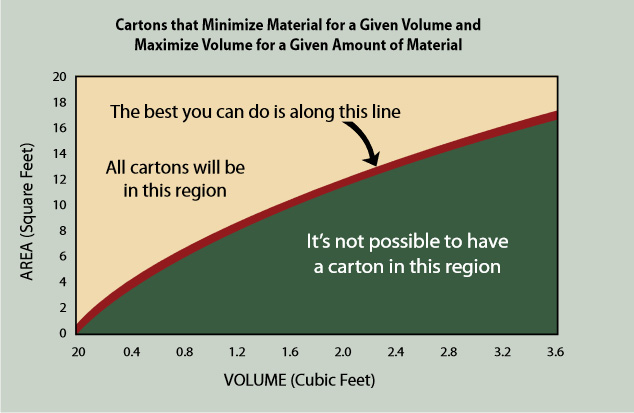Optimal Cartons “Green-Up” Our Supply Chains—And Our Profit-and-Loss Statements
By Terry Harris, Managing Partner, Chicago Consulting
Long unrecognized, we logisticians and supply chain management professionals, are environmentally-responsible, and naturally so. We strive to use fuel-efficient transportation methods—economical ocean container ships, stack-trains that minimize fuel per pound-mile. We use truckload (TL) over less-than-truckload (LTL) whenever practicable, parcel sparingly, and air modes as a last resort. We design optimal warehouse networks and streamline our trucks to conserve fuel. We automate ways to turn off lights in our warehouses when workers are not nearby. We task supply chain executives to spearhead environmental initiatives throughout our companies. We measure our “supply chain carbon footprint.” We are green!
Less recognized, a recent environmental achievement, is the reduction of CO2 emissions stemming from efficient packaging design. Corrugated cartons are made from paper, a forest product that consumes trees. Producing corrugated material emits CO2. Some have said that every pound of corrugate produced releases five pounds of CO2 into the atmosphere.
Efficiently-designed cartons use less corrugated material. Optimally-designed ones use the least.
Think about it. A carton has a certain volume. But there are lots of shapes that enclose the same volume—8”x 8”x 10,” 16”x 10”x 4,” and 8”x 5”x 16” all contain 640 cubic inches. But which ones use less material; are any optimal, using the least possible amount of material?
Carton shapes are often influenced, even dictated, by their contents. However, we can start with designs that use the least material and compromise after that. Moreover, as the contents turn out to be granular, the volume alone becomes critical. Then we can—and should—design the carton to have the least material possible.
Look at Wheaties cereal, “The Breakfast of Champions.” It’s pretty granular stuff. A 15.6 ounce consumer package of Wheaties measures 7 and 11/16”x 2 and 11/16”x 11 and ¾,” and has a volume of 242.8 cubic inches. An optimally-shaped container with that volume would save 7.2% of the material consumed by this package. The same idea applies to the carton that contained the 14 Wheaties consumer packs shipped to the grocer. It measures 15.4”x 11.8”x 18.8.” Designed optimally, it would save 23% of that corrugated material. Use a different case count, and the savings go up to 35%!
Now, extend these savings against the packages of Wheaties consumed annually. Then apply them to other breakfast cereals, to other foods, then against the total corrugated carton consumption. Do the math and you’ll get the idea.
Minimum Material
The material consumed by a corrugated carton is the area of the rectangle it was folded from. There is a necessary area, a minimum area needed, for any carton with a specific volume. Conversely, there is a natural limit, a maximum, to the volume a carton that has a given area can have. This optimal relationship between area and volume is illustrated in the figure below for any size carton.
Optimal Cartons

Costs
So, you say you’re not an environmentalist and don’t care about green. Okay, then care about cost. By and large, the cost of corrugated cartons—actually, almost any high-volume packaging material—is proportional to the amount of material they consume. So, being cost-conscious is congruent with being green… automatically.
What about other costs, transportation in particular? It turns out that, for shippers, the transportation cost associated with carton design is about ten times the corrugated material cost. You might think that transportation concerns would dominate. Here again, green CO2 concerns parallel cost concerns. Companies have products to ship—volume, pounds, density. It can be done in many different ways, with many different carton designs.
Cartons use corrugated material (why not minimize this?); the whole order has to be shipped (why not minimize the number of cartons needed to ship the order?); cartons may have to fit on a pallet (why not maximize the volume or weight the pallet holds?); pallets fit in a trailer (why not maximize trailer utilization?); cartons have weight and figure in the tare weight of the shipment; and so on.
Example
A 12,000 order per day pick-and-pack operation recently optimized its carton regime—the set of cartons it can select from. Transportation costs played a major role, as did material costs. Adding a bigger optimal carton decreased the number of cartons needed to complete orders and the resulting parcel freight bill. It and smaller optimal cartons saved over five-million square feet of corrugated material annually. That’s enough to cover 100 football fields a year!
Long seen by the rest of our organizations as the cost-driven efficiency police, we logisticians are natural environmentalists. Our inherent cost-consciousness conserves financial
resources and natural resources along the way. Optimizing cartons is a chance to expand our environmental responsiveness and boost our cost-reduction image.
Green is the color of money, too.
This article appeared in the Council of Supply Chain Management Professional’s newsletter, CSCMP Supply Chain Comment, Volume 42, Mar./Apr. 2008. CSCMP Supply Chain Comment is published six times a year by CSCMP.







